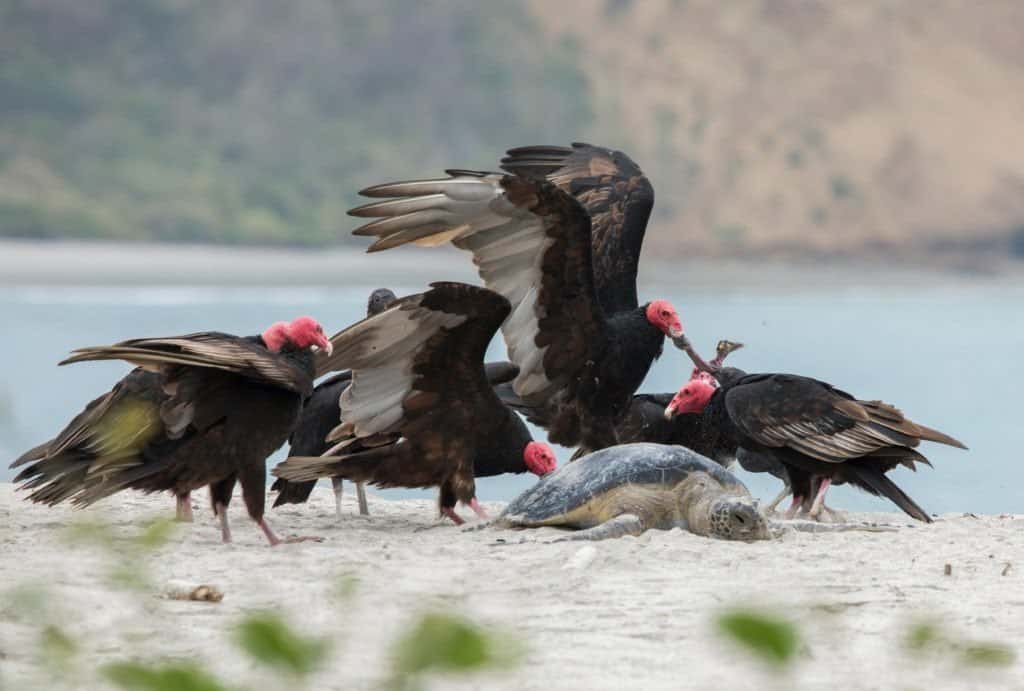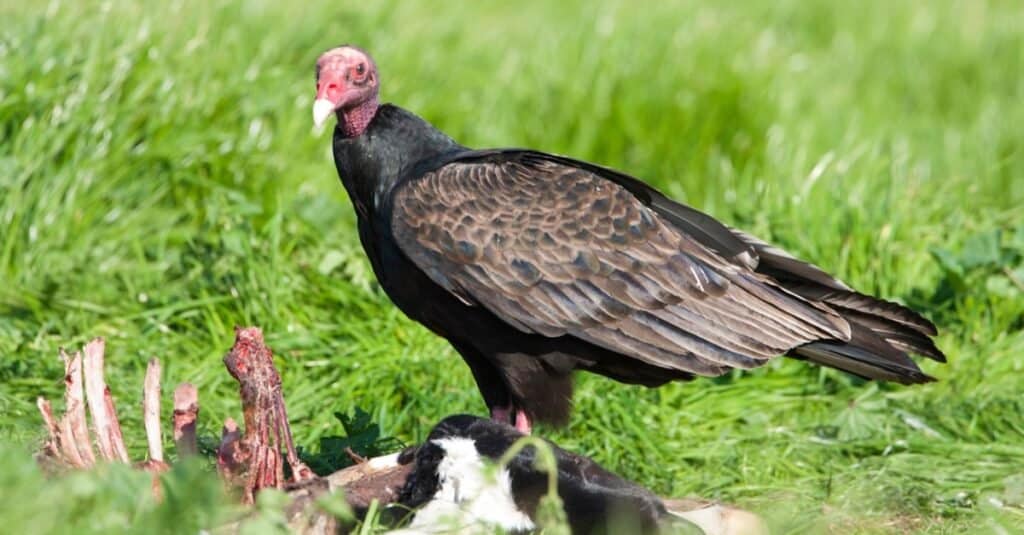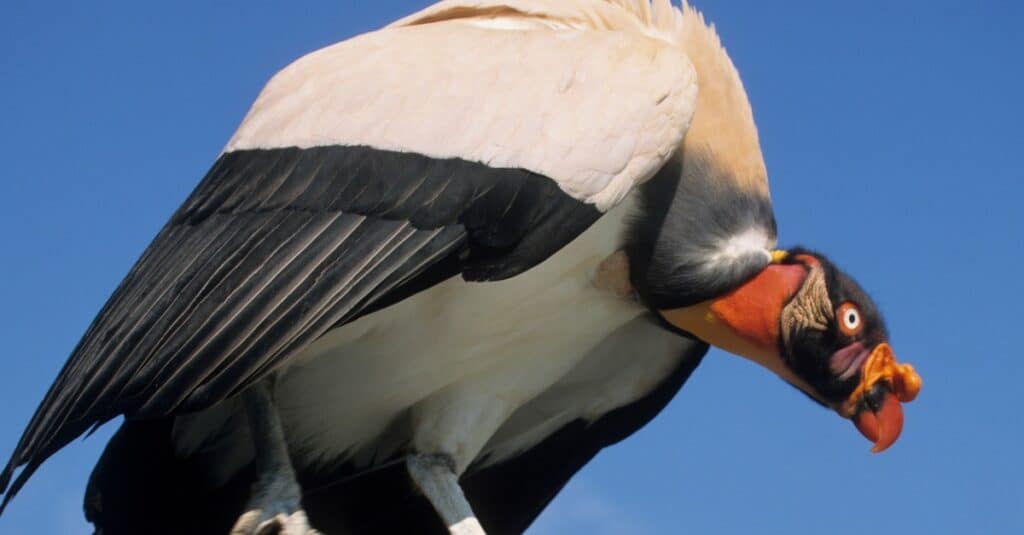Vultures are generally regarded as gross animals that we would rather not think about. We often see them perched on cell towers or greedily attacking hunks of meat on the side of the road. While they may not be the prettiest of birds, vultures are important parts of the ecosystems they live in. Part of that importance involves finding rotting food. There is a reason that sayings like “when the vultures start circling” exist! Let’s talk about these interesting birds and learn: why do vultures circle?
Why do vultures circle?

Vultures circle the air while they are looking for food with their incredible eyesight.
©Rob Hainer/Shutterstock.com
Circling vultures have been an omen of bad luck for a very long time. While those rumors and beliefs may still persist, there are actually some good reasons why vultures circle in the air before dropping down to feed. Let’s take a look at some of the most likely options.
The exact reason vulture circles may be specific to the situation, but most of the time, it has to do with food. They may either be waiting for a predator to finish dinner or waiting for a fellow avian to seek out lunch.
Sight is an important element for vultures on the hunt for fresh meat. As they fly around, anything catching their eyes may need some longer analysis. As they circle, they use their incredible eyesight to make sure that what they are seeing is actually carrion.
Once they confirm that the thing they are seeing is actually carrion, they may want to make sure it’s okay to eat. Vultures are known to eat rotting meat, but they still have preferences. Generally, a vulture will prefer freshly dead meat to putrid meat. Most of the time, a 1-3 day carcass is ideal for the carrion feeders. Any more than that, and even professional eaters like vultures will move on to a different source.
After a carcass has been identified as fresh (but not too fresh), a vulture will make sure that there aren’t any other predators moving on the find. While vultures may be the most famous carrion-eaters around, they aren’t the only ones. Large predators that have recently killed will sometimes take naps around the kill in order to come back and feed later. If a lion or cougar woke up to find a flock of birds stealing their kill, things could become fatal for the vultures. Checking to make sure that they are the only ones (or at least the biggest ones) is a way to ensure their safety.
Finally, a circling vulture may attract other vultures. While this may seem to be counterintuitive, vultures often need to work together to find, defend, and even consume a kill.
An interesting note, however, is that a circling vulture doesn’t always mean food. Vultures are notoriously bad fliers and rely on thermal currents in the air to soar. When they are looking for food, it’s significantly easier for them to soar on these thermals, often sending them in wide circles as the air carries them around.
How do vultures find food?

Turkey vultures have some of the best senses of smell in all the bird kingdom.
©Ana Dracaena/Shutterstock.com
There are two main ways that vultures find food: through sight and smell.
Vultures generally can’t smell, but a few species can—notably, the turkey vulture. The turkey vulture has one of the most developed olfactory organs of any bird species in the world. Using this amazing sense of smell, they are able to seek out carrion that has freshly died. As a result, it’s not often that you see turkey vultures circling. In fact, many other vulture species (like the black vulture) will circle in the air, waiting to see if what the turkey vulture has found is good to eat.
When a vulture doesn’t have a sense of smell, they have to rely purely on sight. This is a much harder way to find food, but it does work. All Old World vultures (those living in Europe, Asia, and Africa) rely on sight to find food. Their sense of smell is either non-existent or really bad. The white-backed vulture in Africa, for example, exclusively uses their eyesight to look for kills.
How does a vulture eat rotting meat without getting sick?

The Turkey Vulture’s method of self-defense is to vomit their food, which they can send sailing 10 feet.
©Agami Photo Agency/Shutterstock.com
Vultures are able to eat rotting meat without much trouble. This is due to their strong stomach acid and an intense microbial environment. Their stomach acid is corrosive, generally floating around a pH of 1.0. For reference, battery acid is around a 0 on the scale. This harsh environment allows them to process food with viruses and bacteria that other animals couldn’t.
Additionally, vultures have two important microbes in their guts that make all the difference when it comes to dangerous pathogens. Clostridia and Fusobacteria are the two important microbes in their stomachs. Clostridia is a microbe that produces toxins, including the one that causes botulism. Fusobacteria is quite literally flesh-eating, which makes sense given the vulture’s diet.
Their stomachs are so strong that DNA from their meals doesn’t even make it through their digestion.
How do vultures help each other eat?

King vultures have the strongest beaks and skulls of the vultures, allowing them to open tough hides for smaller species.
©iStock.com/Michel VIARD
There are a few reasons that signaling to other vultures that food is nearby would be a good thing. One of the most important ones is a vulture’s ability to eat large carcasses, especially ones with thick skin. An example of this is the yellow-headed vultures and king vultures in South America. Yellow-headed vultures are one of the few species that can smell, allowing them to find carcasses much easier than vultures that hunt only by sight (like the king vulture). There is a drawback, however. Yellow-headed vultures aren’t strong enough to rip open the skin of large animals. In fact, the king vulture is often the only scavenger strong enough to “start” the feast at all.
As a result, the king vulture will follow the yellow-headed vultures to food, where they will signal the king vulture that they need help. The relationship is a cross-species example of dependency and working together – something that happens more often in the animal world than we realize.
The photo featured at the top of this post is © Dr. C.J. Nortier/Shutterstock.com
FAQs (Frequently Asked Questions)
What do turkey vultures eat?
Turkey vultures eat the same diet as other vulture species. They are opportunistic omnivores that eat carrion, young or sick animals and fruits and vegetables.
Thank you for reading! Have some feedback for us? Contact the AZ Animals editorial team.






